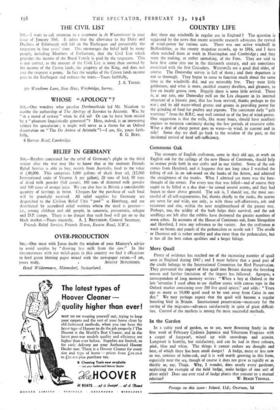Commons Oak The accounts of English craftsmen, some in their
old age, at work on English oak for the ceilings of the new House of Commons, should help to'restore pride both in our crafts and in our timber. Some of the oak comes from Hereford, and it happens that not long since I watched the felling of oak in an oak-wood on the banks of the Arrow, and admired the straightness of the trunks. What I admired yet more was the fore- thought of the owner. For every tree that was felled—and of course they ought to be felled at a due date—he sowed several acorns, and they had begun to show above ground. The oak is, I should say, the most suc- cessful of all self-regenerators, for; thanks chiefly to the rooks, the acorns are sown far and wide, not only, as with those self-afforesters, ash and sycamore and elm, within the near neighbourhood of the parent tree. Perhaps, too, the acidity of the bark helps their survival, and the oak seedlings are left after the rabbits have destroyed the greater numbers of sown ashes. In accounts of the House of Commons oak, from Shropshire and Hereford, I miss any reference to the variety. Are the craftsmen at work on beams and panels of the pedunculate or sessile oak ? The sessile or Durmast oak is rather smaller and also rarer than the pedunculate, but it has all the best oaken qualities and a larger foliage.


































 Previous page
Previous page